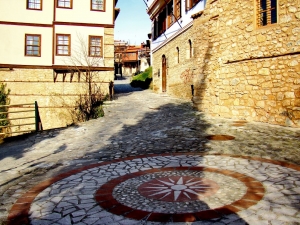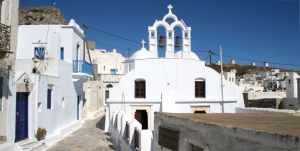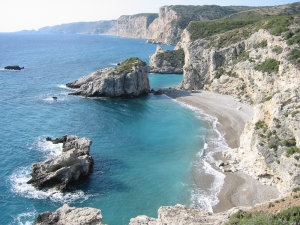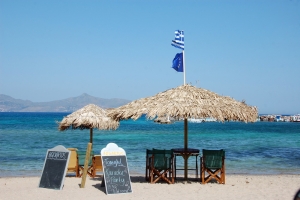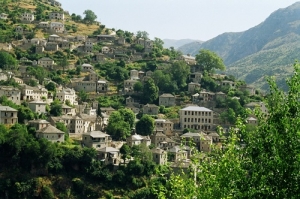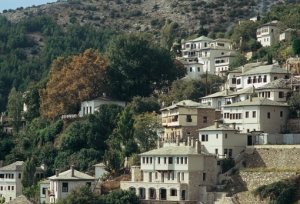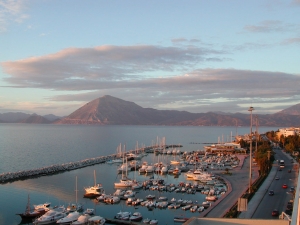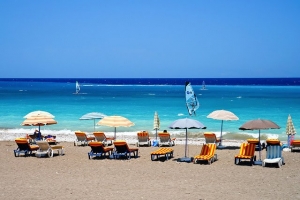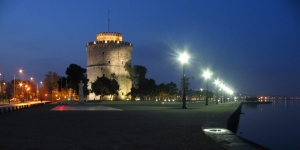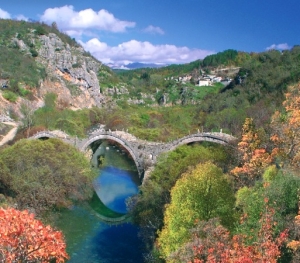Where: Only a few kilometres away from the busy port of Volos in Thessaly stands mythical Mt. Pilion, which according to Greek mythology was the home of the mythical Centaurs, creatures who were half man and half horse. Ancient Greek heroes such as Achilles, Jason and Theseus came to Mount Pilion to master the arts taught by the Centaurs.
Mount Pilion is home to 24 beautiful villages. Why: The unique combination of superb natural surroundings, dense greenery, cascading waterfalls and gorges, romantic bays with crystal clear waters and outstanding local architecture make for a “four seasons’ destination” that attracts visitors all year long.
Must visit: Pilion boasts some of the most famous traditional villages in Greece; set against an idyllic backdrop of shimmering olive groves, dense forests and lush fruit orchards, these stone-built villages are the true gems of Pilion. Visit the lovely old village of Tsagaráda –home to a 1,000-year-old plane tree; Makrinitsa, the so-called balcony of Pilion, which affords magnificent views over the Aegean; Portaria, which thanks to its impressive traditional mansions has successfully managed to preserve its traditional colour untouched by time, and Chánia, with its famous ski centre.
Activities on offer: Explore this unspoiled world on horseback! The horseback trip starts in Argalasti, an attractive village in the south of the peninsula. From here you can reach beaches on both sides of the peninsula – open sea or calm gulf. The cobblestone trails between villages lead you back through time and are ideal for rides on horseback. The main trails out of Argalasti lead to many interesting locations, such as Kalamos (6 km to the west) and Lefokastro (6 km to the NW). Ski down snowy slopes at the ski resort of Agriolefkes near the village of Chánia or walk along narrow winding cobbled paths known as calderimia. The Chánia-Kissós path is one of the most popular among trekking lovers.
Hot tips:
• Discover one of Pilion’s best kept secrets: the tiny, exquisite cove of Fakistra; the highlight is a stream that springs from the mountain and flows into the sea. It is rather difficult to get down to it but it certainly worth it; even in winter the setting is very romantic; pure magic.
• Follow a scenic route from the village of Milies...by train! Take the legendary Pelion stream train, a narrow-gauge rail track built more than a century ago by the father of the surrealist painter Giorgio de Chirico, which crosses stone bridges and passes through rugged landscapes; all the stations are of unique architectural interest.
• Visit the village of Damouchari, where several scenes from the movie Mamma Mia were filmed!
Accommodation: Ancient old mansions of traditional Pelian architecture that used to belong to rich merchants have been turned into cosy guesthouses offering an exquisite atmosphere that is difficult to find anywhere else in Greece.
Famous local products: Taste mouth-watering pies and home-made “spoon sweets” (a traditional dessert consisting usually of fruit preserved in syrup) produced by local women’s associations with all kinds of local fresh fruit!
Zagorochoria villages
Where: At the heart of Epirus, nestling among the steep and snowy slopes of the Týmfi mountain range.
Why: A complex of 46 picturesque traditional villages built in a magical setting amidst pine and fir trees with one of the most beautiful and diverse ecosystems in Europe. Its unique traditional architecture, impressive stone mansions and undulating, natural forest surroundings are the perfect ingredients for an unparalleled destination, ideal for action-packed holidays!
Must visit: Visit Zagóri’s most picturesque villages; Monodéndri is a restored stone village. Stroll down its narrow streets past the village’s stone courtyards; take the rocky trail starting from the central square that leads you to Vickos Gorge, which is awe-inspiringly deep! From there, admire the Monastery of St. Paraskevi nestling on a rock overlooking the Vickos Gorge. Mikro and Megalo Papigko, Aristi, Kipi and Dilofo are just some of the precious gems of Zagori. Gaze at the beautiful stone bridges which connect the villages. These are architectural masterpieces of superb craftsmanship which are often associated with legends and other local traditions.
Activities on offer: Trekking lovers will have the chance to hit a variety of mountain trails in Zagorochoria. Cross the Vickos Gorge following the route from Monodéndri north to Vikos- Vikos to Pápigo, and Monodéndri south to Kipi, a traditional small village with old arched stone bridges. The route is quite long (it lasts at least 5 hours), but it is a very rewarding experience! Starting from Pápigo you can take a much easier, three-hour trail; follow the path leading to Astráka refuge and then head for the summits of Astráka and Lápatos.
Hit the trails that connect the villages Pápigo and Mikró Pápigo through the Vikos-Aoós National Forest; go for an invigorating swim in the two natural forest lakes. The village of Vovoúsa in eastern Zagori is ideal for bird watching as it is located near the National Park of Valia Kalda, a protected forest populated with rare species of flora and fauna.
Hot tips:
• Follow the mountain trails to Kípi, an ideal mountain tourism destination: cross its two rivers (Vikákis and Baniótikos) using the Kaloyerikó (or Plakidas), a three arch bridge with a serpentine deck.
• Explore the magical “Drakolimni”, one of the three alpine lakes in the Pindus mountain range, which according to local legends used to be inhabited by dragons!
• Don’t miss the opportunity to walk the famous Vradeto Stairs at the edge of Vickos Gorge. These stone 1,200 meter stairs connect the villages Vradéto and Kapésovo, and they were the only access to Vradéto village until 1973!
• Trekking through the Asprággeli, Dikóryfo, Manassís and Kaloutás villages, you will find the Kaloutás Bridge, which used to connect the village to with the Vissikoú Monastery (dedicated to the Dormition of the Virgin Mary).
Accommodation: Traditional stone-built guesthouses offer a warm environment to rest in after your day has come to an end; enjoy a glass of fine wine by the fireplace before going to sleep or a delicious breakfast with fresh local products before starting your day!
Famous local products: Experience the true magic of Zayorohória: have a delicious meal in a mezedopoleío (local tavern) and taste the famous local pies accompanied by sweet local wine!
Mountainous Arcadia
Where: Among the steep slopes of Mt. Mainalo in the Peloponnese nestle the mountain villages of Dimitsána, Stemnítsa and Vytína.
Why: Get a deeper insight into Greek history by visiting the places where the Greek Revolution of 1821 against the Turks actually began; a place synonymous with legendary heroes, fierce battles and glorious achievements. Today thanks to its proximity to Athens and its striking beauty Mountainous Arcadia is one of the most popular winter destinations in Greece.
Must visit: The village of Dimitsána; built like an amphitheatre overlooking the Lousios River, Lousios valley and the plains of Megalopoli, Dimitsána is nicely surrounded by snow covered mountain tops and lush pine tree forests. Some of its most famous sights are the six remaining legendary Gunpowder Mills that used to produce gunpowder for the Revolutionary War, the Philosophou and Timiou Prodromou Monasteries; the archaeological site of Gortyna and the houses of heroes of the Revolution.
The village of Stemnitsa is a typical traditional Arcadian settlement set amidst ancient plane and fir trees. It boasts grand stone mansions, Byzantine churches, cobblestone paths, a beautiful square and an interesting Folklore Museum.
At the heart of Mountainous Arcadia, among the slopes of Mt. Mainalo, lies the most popular tourist destination in Arcadia, Vytina, famous for its unique architecture and blessed with a rugged landscape. Home to a number of legendary heroes of the Revolutionary War, Vytína faced the rage of the Turks many times and the village was burned down on 7 occasions! Vytína used to be an important centre of for the textile industry and woodcraft but today the economy is largely based on tourism.
Activities on offer: Go rafting down the Lousios River; if you are a trekking fan hit the mountain trails and take in the breathtaking scenery or glide down snowy mountain slopes at Mainalo ski resort, an ultra modern ski centre with first-class facilities.
Hot tips:
• Visit the Open Air Water-Power Museum in Dimitsána, the only museum of its kind, which demonstrates basic pre-industrial techniques using water as the main source of energy to produce a variety of goods.
• Stroll around the picturesque district of Kastro in Stemnitsa and take in an amazing view of the Margaritsa Gorge sprawling below.
• Visit the Folklore Museum, the “Greek School” and the Library of Vytína, where you can admire rare books and manuscripts.
Accommodation: Impressive stone mansions turned into cosy family run guesthouses or first-class hotels offer a wide range of facilities and a cosy atmosphere to relax in with your family or to enjoy romantic moments by the fireplace with your other half.
Famous local products: Sample sweet-smelling honey, crunchy nuts, fresh dairy products, delicious local cheese or healing herbal infusions; don’t forget to buy local folklore items like wooden sculptures or textiles before you leave.
Source: Visitgreece.gr

